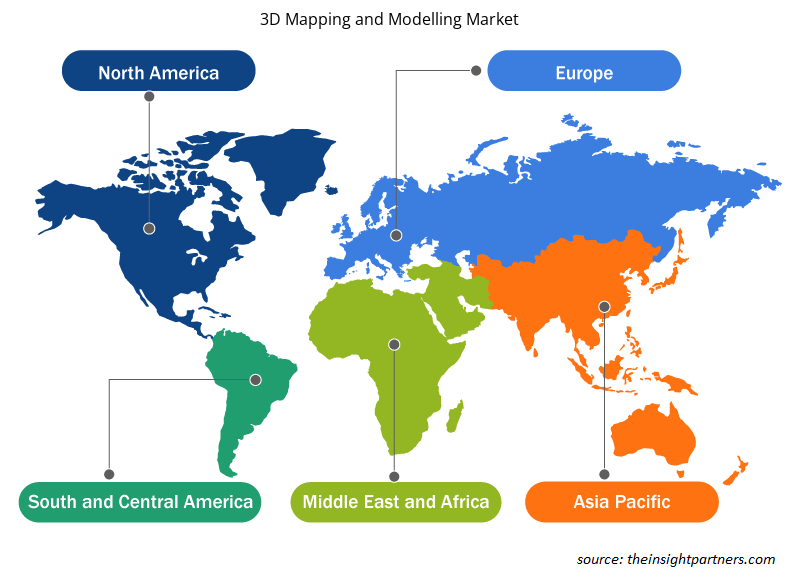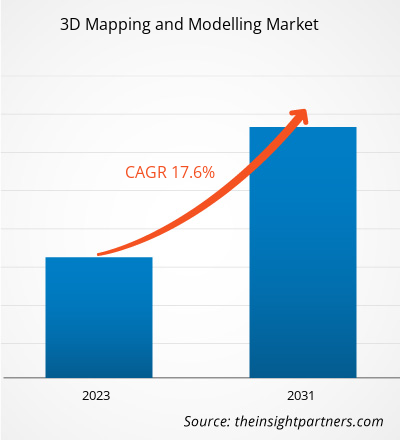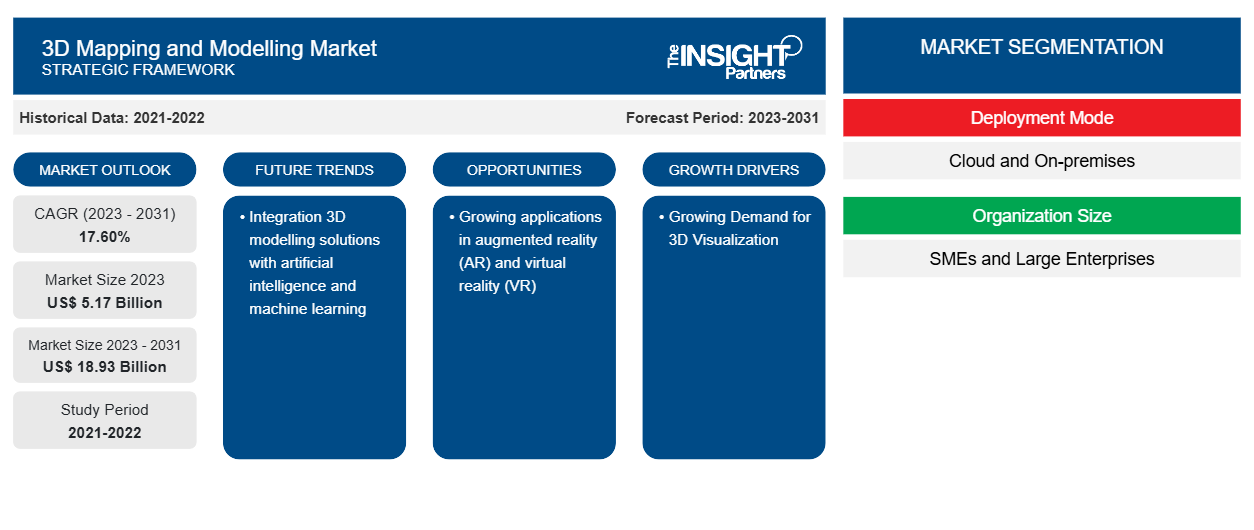Se proyecta que el tamaño del mercado de mapeo y modelado 3D alcance los 18,93 mil millones de dólares estadounidenses para 2031, desde los 5,17 mil millones de dólares estadounidenses en 2023. Se espera que el mercado registre una CAGR del 17,60 % durante 2023-2031. Es probable que la integración de soluciones de modelado 3D con inteligencia artificial y aprendizaje automático siga siendo una tendencia clave en el mercado.
Análisis del mercado de modelado y mapeo 3D
La creciente necesidad de animación 3D, los avances técnicos en equipos de escaneo 3D, la creciente demanda de contenido 3D y un aumento en los dispositivos de visualización 3D son algunos de los principales impulsores del mercado mundial de mapeo y modelado 3D. Además, el creciente uso e integración de tecnologías como la inteligencia artificial y el aprendizaje automático en el software de mapeo y modelado 3D para mejorar la precisión del contenido 3D está impulsando la expansión del mercado. Se espera que todas estas razones brinden suficientes posibilidades de desarrollo para los participantes del mercado durante el período de pronóstico.
Descripción general del mercado de modelado y mapeo 3D
Las plataformas de mapeo y modelado 3D permiten a los usuarios crear modelos y mapas tridimensionales básicos de elementos y ubicaciones. Estas tecnologías también ayudan en la visualización , cuestionamiento, análisis e interpretación de datos geográficos/de ubicación, lo que permite a los usuarios comprender los vínculos, patrones y tendencias entre varios factores para resolver desafíos comerciales del mundo real. Las empresas y las personas en todo el mundo utilizan tecnologías de mapeo y modelado 3D para mejorar las operaciones, aumentar la eficiencia y maximizar la utilización de los recursos al identificar áreas problemáticas y elementos que requieren cambios. Estas herramientas se utilizan comúnmente en empresas centradas en la tierra, como ingeniería y construcción, fabricación, transporte y logística, y muchas otras para aplicaciones de gestión de servicios de campo, gestión de pisos, gestión de activos y gestión de inventario. Las herramientas 3D también se utilizan para aplicaciones de diseño de construcción/arquitectura e ingeniería civil. El lidar, el sonar, el radar y la fotogrametría son algunas de las técnicas de mapeo 3D más comunes, y el modelado 3D puede comprender modelado de estructura alámbrica, de superficie y sólido.
Personalice este informe según sus necesidades
Obtendrá personalización en cualquier informe, sin cargo, incluidas partes de este informe o análisis a nivel de país, paquete de datos de Excel, así como también grandes ofertas y descuentos para empresas emergentes y universidades.
-
Obtenga las principales tendencias clave del mercado de este informe.Esta muestra GRATUITA incluirá análisis de datos, desde tendencias del mercado hasta estimaciones y pronósticos.
Impulsores y oportunidades del mercado de modelado y mapeo 3DModelling Market Drivers and Opportunities
La creciente demanda de visualización 3D favorecerá el mercado
Existe una creciente necesidad de visualización 3D en varias industrias. El uso de tecnología de efectos visuales (VFX) en películas, el uso de aplicaciones móviles y juegos 3D y la creciente tendencia del marketing digital contribuyen al crecimiento del mercado de mapeo y modelado 3D. Por ejemplo, el negocio de los juegos utiliza la visualización 3D para crear experiencias inmersivas utilizando materiales, personajes y ubicaciones de juegos 3D. Las industrias de marketing y venta minorista emplean la visualización 3D para la creación de prototipos, el desarrollo de elementos visuales para campañas y la mejora de las experiencias de los consumidores. Además, la visualización 3D es esencial en el cuidado de la salud para aplicaciones que incluyen imágenes médicas , planificación quirúrgica y educación del paciente.VFX) in films, the usage of 3D mobile apps and gaming, and the rising trend of digital marketing are all contributing to the growth of the 3D mapping and modelling market. For instance, the gaming business uses 3D visualization to create immersive experiences using 3D game materials, characters, and locations. The marketing and retail industries employ 3D visualization for prototyping, developing visuals for campaigns, and improving consumer experiences. Moreover, 3D visualization is essential in healthcare for applications including
Crecientes aplicaciones en realidad aumentada (RA) y realidad virtual (RV)
Las tecnologías de realidad aumentada (RA) y realidad virtual (RV) se están expandiendo rápidamente y se están implementando en una variedad de sectores. Estas tecnologías utilizan modelos 3D para crear experiencias digitales inmersivas que cambian la forma en que los usuarios interactúan con el mundo que los rodea. La RA facilita el mundo real al incorporar componentes digitales como fotos, videos y texto en entornos físicos. Permite la superposición de información digital sobre cosas del mundo real, mejorando nuestra percepción y conocimiento del entorno. La RV, por otro lado, crea experiencias completamente virtuales al transferir a los usuarios a entornos creados digitalmente. Desarrolla simulaciones inmersivas que pueden utilizarse para la enseñanza, el entretenimiento y otros fines.
Análisis de segmentación del informe de mercado de modelado y mapeo 3D
Los segmentos clave que contribuyeron a la derivación del análisis del mercado de modelado y mapeo 3D son el modo de implementación, el tamaño de la organización, el componente, la aplicación de mapeo 3D, la aplicación de modelado 3D y la vertical.
- Según el modo de implementación, el mercado está segmentado por la nube y las instalaciones locales. El segmento local dominó la participación de mercado en 2023.
- Según el tamaño de la organización, el mercado se segmenta en pymes y grandes empresas. El segmento de grandes empresas tuvo la mayor participación del mercado en 2023.
- Según los componentes, el mercado se segmenta en herramientas y servicios de software. El segmento de herramientas de software tuvo la mayor participación del mercado en 2023.
- Basado en la aplicación de mapeo 3D, el mercado está segmentado en inspección y medición, reconstrucción de objetos, proyección y navegación, generación de informes y virtualización, y otras aplicaciones de mapeo 3D. El segmento de inspección y medición tuvo la mayor participación del mercado en 2023.
- Basado en la aplicación de modelado 3D, el mercado está segmentado en marketing de productos, animación y películas, juegos y diseño, renderizado arquitectónico y otras aplicaciones de modelado 3D. El segmento de marketing de productos tuvo la mayor participación del mercado en 2023.
- Según el sector vertical, el mercado está segmentado en comercio minorista y bienes de consumo, ingeniería y construcción, atención médica y ciencias biológicas, transporte y logística, gobierno y defensa, energía y servicios públicos, medios de comunicación y entretenimiento, fabricación y otros sectores verticales. El segmento de ingeniería y construcción tuvo la mayor participación del mercado en 2023.
Análisis de la cuota de mercado de modelado y mapeo 3D por geografía
El alcance geográfico del informe de mercado de modelado y mapeo 3D se divide principalmente en cinco regiones: América del Norte, Asia Pacífico, Europa, Medio Oriente y África, y América del Sur y Central.
América del Norte dominó el mercado de modelado y mapeo 3D en 2023. Este dominio se puede atribuir al ecosistema en desarrollo de la región de empresas impulsadas por la tecnología. La construcción, la planificación urbana y los automóviles sin conductor se benefician del uso de la tecnología de modelado y mapeo 3D. Además, América del Norte alberga empresas clave en mapeo y modelado 3D, incluidas Autodesk, Trimble, Inc. y Bentley Systems, entre otras. La existencia de estas empresas, junto con su experiencia y recursos, se suma a la supremacía del mercado de la región.
Perspectivas regionales del mercado de modelado y mapeo 3D
Los analistas de Insight Partners explicaron en detalle las tendencias y los factores regionales que influyen en el mercado de mapeo y modelado 3D durante el período de pronóstico. Esta sección también analiza los segmentos y la geografía del mercado de mapeo y modelado 3D en América del Norte, Europa, Asia Pacífico, Medio Oriente y África, y América del Sur y Central.

- Obtenga datos regionales específicos para el mercado de modelado y mapeo 3D
Alcance del informe de mercado de modelado y mapeo 3D
| Atributo del informe | Detalles |
|---|---|
| Tamaño del mercado en 2023 | 5.170 millones de dólares estadounidenses |
| Tamaño del mercado en 2031 | US$ 18,93 mil millones |
| CAGR global (2023 - 2031) | 17,60% |
| Datos históricos | 2021-2022 |
| Período de pronóstico | 2023-2031 |
| Segmentos cubiertos |
Por modo de implementación
|
| Regiones y países cubiertos |
América del norte
|
| Líderes del mercado y perfiles de empresas clave |
|
Densidad de actores del mercado: comprensión de su impacto en la dinámica empresarial
El mercado de modelado y mapeo 3D está creciendo rápidamente, impulsado por la creciente demanda de los usuarios finales debido a factores como la evolución de las preferencias de los consumidores, los avances tecnológicos y una mayor conciencia de los beneficios del producto. A medida que aumenta la demanda, las empresas amplían sus ofertas, innovan para satisfacer las necesidades de los consumidores y aprovechan las tendencias emergentes, lo que impulsa aún más el crecimiento del mercado.
La densidad de actores del mercado se refiere a la distribución de las empresas o firmas que operan dentro de un mercado o industria en particular. Indica cuántos competidores (actores del mercado) están presentes en un espacio de mercado determinado en relación con su tamaño o valor total de mercado.
Las principales empresas que operan en el mercado de mapeo y modelado 3D son:
- Autodesk
- Saab AB
- Software dorado
- Recortar
- Sistemas Bentley
- Alfabeto
Descargo de responsabilidad : Las empresas enumeradas anteriormente no están clasificadas en ningún orden particular.

- Obtenga una descripción general de los principales actores clave del mercado de mapeo y modelado 3D
Noticias y desarrollos recientes del mercado de modelado y mapeo 3D
El mercado de mapeo y modelado 3D se evalúa mediante la recopilación de datos cualitativos y cuantitativos posteriores a la investigación primaria y secundaria, que incluye publicaciones corporativas importantes, datos de asociaciones y bases de datos. A continuación, se enumeran algunos de los desarrollos en el mercado de mapeo y modelado 3D:
- Autodesk anunció el Proyecto Bernini. Este nuevo esfuerzo de investigación ofrece el primer modelo de IA generativo experimental que genera rápidamente formas 3D superiores a partir de una variedad de entradas, incluida una sola imagen 2D, múltiples imágenes que muestran diferentes vistas de un objeto, nubes de puntos, vóxeles y texto. El Proyecto Bernini tiene como objetivo crear modelos generativos que puedan usarse en diferentes campos, como la arquitectura, el diseño de productos, el entretenimiento y más, para generar estructuras 3D funcionales que puedan usarse en aplicaciones del mundo real y que se alineen con la visión del diseñador. (Fuente: Autodesk, comunicado de prensa, mayo de 2024)
- Trimble anunció el sistema de escaneo láser 3D Trimble X9, una nueva solución versátil de captura de la realidad para profesionales de la topografía, la construcción y la ingeniería. El X9 se basa en las probadas tecnologías de escaneo láser de Trimble, diseñadas para mejorar el rendimiento en más entornos y, al mismo tiempo, aprovechar innovaciones como la tecnología Trimble X-Drive para la calibración automática de instrumentos, la autonivelación de calidad topográfica y el puntero láser para georreferenciación. (Fuente: Trimble, comunicado de prensa, junio de 2023)
Cobertura y resultados del informe de mercado de modelado y mapeo 3D
El informe “Tamaño y pronóstico del mercado de modelado y mapeo 3D (2021-2031)” proporciona un análisis detallado del mercado que cubre las siguientes áreas:
- Tamaño y pronóstico del mercado de modelado y mapeo 3D a nivel global, regional y nacional para todos los segmentos clave del mercado cubiertos bajo el alcance
- Tendencias del mercado de modelado y mapeo 3D, así como dinámica del mercado, como impulsores, restricciones y oportunidades clave
- Análisis detallado de las cinco fuerzas de Porter y PEST y FODA
- Análisis del mercado de modelado y mapeo 3D que cubre las tendencias clave del mercado, el marco global y regional, los principales actores, las regulaciones y los desarrollos recientes del mercado
- Panorama de la industria y análisis de la competencia que abarca la concentración del mercado, análisis de mapas de calor, actores destacados y desarrollos recientes para el mercado de modelado y mapeo 3D
- Perfiles detallados de empresas
- Análisis histórico (2 años), año base, pronóstico (7 años) con CAGR
- Análisis PEST y FODA
- Tamaño del mercado, valor/volumen: global, regional y nacional
- Industria y panorama competitivo
- Conjunto de datos de Excel
Informes recientes
Informes relacionados
Testimonios
Razón para comprar
- Toma de decisiones informada
- Comprensión de la dinámica del mercado
- Análisis competitivo
- Información sobre clientes
- Pronósticos del mercado
- Mitigación de riesgos
- Planificación estratégica
- Justificación de la inversión
- Identificación de mercados emergentes
- Mejora de las estrategias de marketing
- Impulso de la eficiencia operativa
- Alineación con las tendencias regulatorias























 Obtenga una muestra gratuita para - Mercado de mapeo y modelado 3D
Obtenga una muestra gratuita para - Mercado de mapeo y modelado 3D